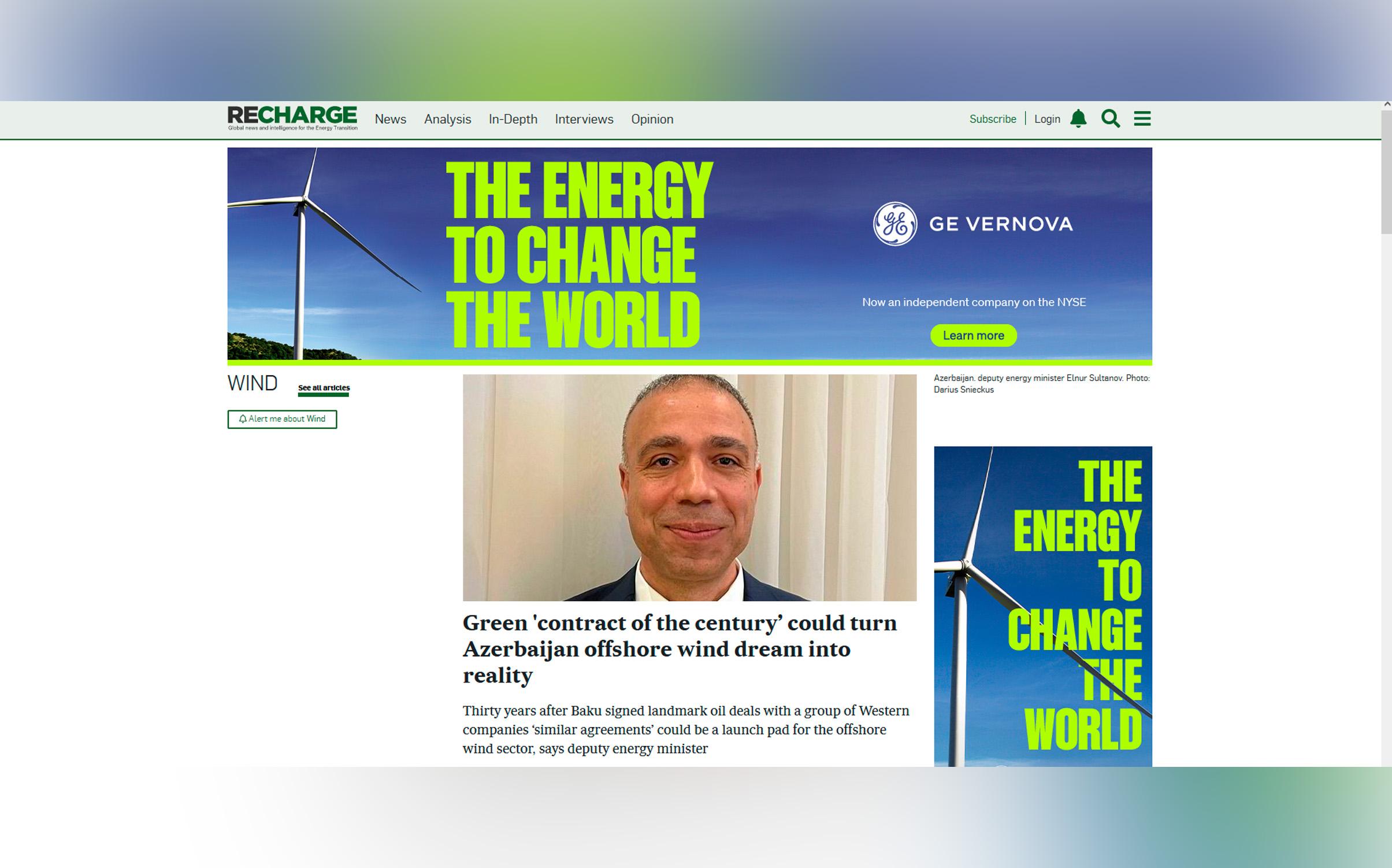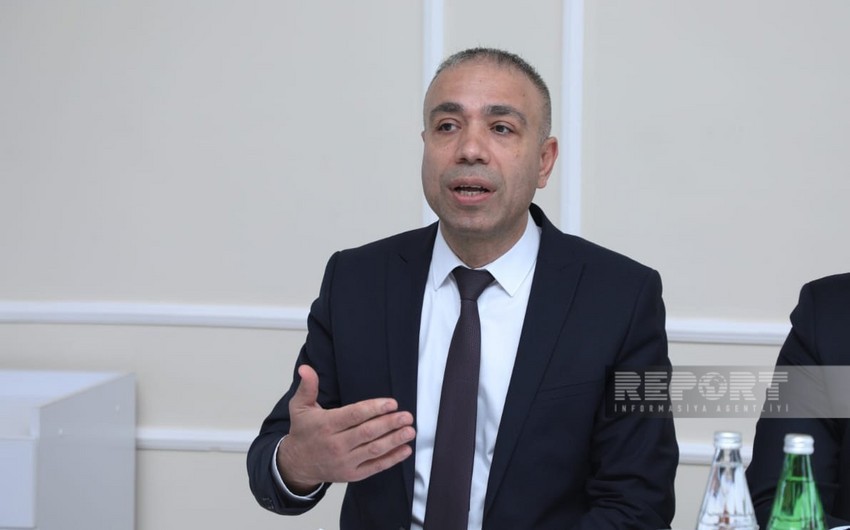Capturing commercial-scale power from Azerbaijan's rich sea winds – seen as central to its ambitions to shift from offshore oil & gas production towards renewables in the coming decades – could call for partnerships with international clean-energy developers similar to the "Contract of the Century” signed with a cadre of Western petro-giants in 1994, according to one of the Caspian nation's top officials, Report informs citing an article by Darius Snieckus published by Recharge.
Deputy energy minister Elnur Sultanov, who is also CEO of the COP29 climate conference being held in Azerbaijan's capital city Baku later this year, suggested the heavy capital demands of building offshore wind farms meant the government would be open to “something like power production sharing agreements” with European developers willing to accelerate the build-out to more than 7GW that the World Bank has "roadmapped’ for 2040.
“Strategic partnerships will always be very important to us [in the energy sector],” Sultanov said, noting the recent tie-ups with Abu Dhabi-headquartered Masdar and the UK’s BP, both of which are building utility-scale renewables projects in Azerbaijan. “Something like [a PSA] could be emerging around Caspian offshore wind because these projects are so big, so challenging and we are landlocked so we have no connection the [wind sector’s] global supply chains.”

Investment by some of the world’s top-tier wind players as part of such deals could uncork not just gigawatts of power — the World Bank calculates pacey deployment of turbines could create a fleet meeting 37% of national demand by the end of the next decade — but also industrial and economic development, he noted.
Yes it's a petrostate, but COP29 host Azerbaijan might be the transition story the world needs
“If we want to develop Caspian offshore wind then you definitely need local [manufacturing], all the components cannot come from European countries [overland],” said Sultanov.
One of the stumbling blocks to progress in commercialising Azerbaijan’s offshore wind resource has been the turbine blades. With only Russia’s relatively narrow Volga canal system connecting the Caspian Sea to Europe directly by waterway, supersize blades, such as those flown by the giant 15MW-plus machines now coming to market, would need to take the time-consuming and costly overland route, at least until local fabrication halls are in place.
A number of technical issues
Teymur Guliyev, deputy vice president for energy transition with Socar, the state oil company, described a number of technical issues that have arisen since the work with the World Bank was announced. One of those he described as the logistics of how to get the blades into the Caspian, with China offering the best value for money but via an overland route "that would be a very significant cost.”
“And even if the Volga was open now [it is closed to trade due to the war in Ukraine] it would not have the dimensions for these blades [which are well over 100 metres in length].”
There is also the wider predicament around permitting for future offshore wind sites in waters cluttered with active oil & gas platforms as well as tanker vessels weaving between the ports on the Caspian.
“Floating [wind],” Guliyev feels, even as a clean energy source for decarbonisation of offshore oil & gas operations, such as Norway’s Equinor is doing on its Snorre-Gulfaks field via the Hywind Tampen project, still looks “way too expensive right now”, though the feasibility of a Socar pilot with France’s TechnipEnergies is still being explored.
Despite the obstacles, Masdar last year signed a deal with the Azeri government to build 10GW of renewable energy plant, including the 2GW Hector offshore wind development. Saudi Arabian developer ACWA Power is also advancing a 1.5GW offshore wind farm with battery energy storage as part of four-project agreement with Baku.
“There will be challenges in integrating these capacities into the [national] grid [with its current 9GW maximum] so we need to think about ‘what’ we are going to do with this energy: not a huge local market, no synchronous electricity market like in the EU to transmit power one country to another smoothly,” said Kamran Huseynov, deputy director of Azerbaijan’s agency for renewable energy sources in the ministry of energy.
"Export to Europe will be key"
“So export to Europe will be key and how we can generate hydrogen and e-fuels from excess energy from future offshore wind plants.”
Whatever the hurdles, if Azerbaijan is to hit its national target of cutting CO2 emissions by 35% by 2030 and 40% by mid-century (from 1990 levels), there is little disputing that offshore wind will be a main engine - not least for a petrostate that aims to decarbonise oil & gas exports accounting for a third of its gross domestic product.
“There is an abundant resource of offshore wind [off Azerbaijan] and it would be a sin and a shame if it is not utilised,” said ACWA Power chief executive Selim Gűven. “We want to develop this resource from two angles: green hydrogen and green electricity. Hydrogen might be better, a better-value form of energy.”
Gűven doesn’t see wind turbine componentry - tower, nacelle, blades, even floating platforms - being problematic. “I think this is a small matter - there are Turkish contractors that could set up a shop here [in Baku] quite quickly. What is more important is the scale. Government only needs to propose support for the first 2GW [of turbines] and support investment in that infrastructure. It is a strategic decision, not a cost,” he said.
Once a fledgling offshore wind fleet is in production, power generated in the Azeri Caspian could flow at a levellised cost of energy at Euro81/MWh for bottom-fixed projects and Euro147/MWh for floating, according to forecasts from Danish intelligence outfit Aegir Insights.
Sultanov believes a mulled 1,200km, 1GW high voltage transmission cable running from the Caspian through to the Black Sea and into Europe would be the best “new route” for renewable power including offshore wind out of the region, as part of a “green corridor” linking Central Asia and the EU states.
“This Trans-Caspian energy corridor would not just be good in terms of supply and demand [of power] over long distances, for ‘connecting’ grids for better balancing,” said Sultanov, “but also for helping [develop] some of the renewable energy resources in the other Caspian countries… a kind of ‘peace power line’.”


 https://static.report.az/photo/10efaf64-fa1e-33d0-991e-610967167a6f.jpg
https://static.report.az/photo/10efaf64-fa1e-33d0-991e-610967167a6f.jpg

